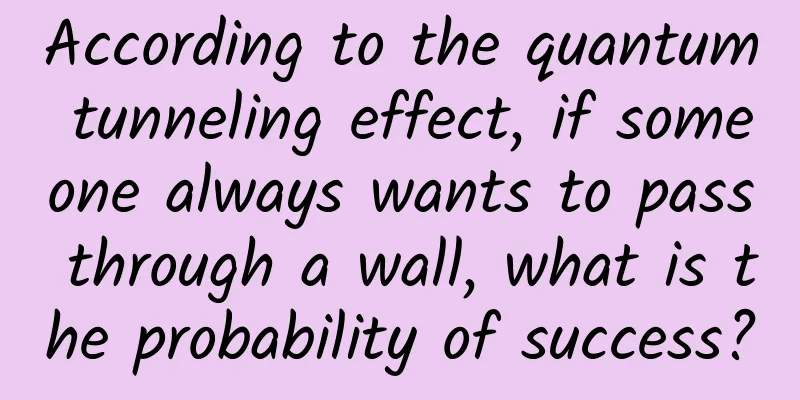According to the quantum tunneling effect, if someone always wants to pass through a wall, what is the probability of success?

|
This article is based on answering a question from netizens: According to the theory of quantum mechanics, if a person hits a wall, what is the probability that he can pass through it? I can tell you responsibly and simply: zero probability. Quantum mechanics describes phenomena that only occur in the quantum realm. The so-called quantum field is the microscopic field. The theory of quantum mechanics is only valid when describing the phenomena in the world of microscopic particles. These phenomena do not exist in the macroscopic world. How small is this microscopic? It is mainly at the subatomic level, which is smaller than an atom. The diameter of the tip of an embroidery needle is about 10μm (micrometer), which is about 0.000001cm^2. This seems very small, but for quantum, it is still an extremely huge macroscopic matter. The diameter of an atom is about 10^-12cm, and the apparent area is about 10^-24cm. In this way, 100 trillion atoms can be arranged on the tip of a needle. Subatomic particles are much smaller than atoms, such as neutrons, protons, and electrons. The diameters of these subatomic particles are all below 10^-17 cm, so 100 trillion trillion of them can be arranged on the tip of a needle. The quantum tunneling effect mainly occurs at the subatomic or atomic level that humans cannot see, and the largest level can only be at the level of certain molecules (such as water molecules). It is completely impossible to reach the size of a needle tip, let alone a macroscopic phenomenon at the level of a human. So I advise those who have such fantasies not to try it, because no matter how many times you hit it, you will get a bloody head, and the harder you hit, the faster you will die, unless the wall is made of tofu. What is the quantum tunneling effect? The theory that causes many people to fantasize about being able to pass through walls and do whatever they want is the result of some people's misunderstanding of the theory of quantum tunneling effect in quantum mechanics. The so-called quantum tunneling effect refers to the quantum behavior of microscopic particles such as electrons that can penetrate or cross potential barriers. Potential barriers are a complex concept, and to explain them clearly requires a series of functional equations and other knowledge (the figure below is just a little bit), which will not be discussed here. In layman's terms, the quantum tunneling effect means that microscopic particles can jump over seemingly insurmountable walls, which are potential barriers that are originally insurmountable. In classical mechanics, that is, in our macroscopic world, this is impossible, but in the quantum world, this particle has the probability of crossing this high wall. Note that this is only a probability, not an absolute. The so-called potential barrier is not a real visible material such as a wall or partition, but energy. Just as the particles in an atom are bound by the energy of the nucleus, logically, super-strong energy is required to jump out of the nuclear energy potential. Therefore, according to the understanding of classical mechanics, these particles cannot escape the nuclear potential. However, in the alpha decay process, the alpha particle is ejected from the nucleus without the need for energy greater than the nuclear potential. This phenomenon can only be explained by the uncertainty principle and wave function of quantum mechanics. After the establishment of this theory, the scientific community has better revealed some phenomena in nuclear fusion, radioactive decay, astrochemistry, and quantum biology inside stars, which has promoted the in-depth scientific research. Scientists have also developed a scanning tunneling microscope based on the theory of quantum tunneling effect. The two inventors, Gerd Binning and Heinrich Rohrer, and the inventor of the electron microscope, Ernst Ruska, shared the 1986 Nobel Prize in Physics. There are many strange phenomena in the quantum world that can only occur at the microscopic level The most famous theories in quantum theory are the uncertainty principle and the collapse of the wave function. The uncertainty principle, also known as the uncertainty principle, was proposed by Heisenberg in 1927. The core content of this theory is that it is impossible for people to know the position and velocity of a particle at the same time, because the uncertainty of the particle's position must be greater than or equal to Planck's constant divided by 4π, and the formula is ΔxΔp≥h/4π. This theory shows that the behavior of particles in the microscopic world is completely different from the movement of matter in the macroscopic world. In our macroscopic world, we can know the position and speed of cars, airplanes, and even spacecraft at the same time, so it is difficult to understand using classical physics. Wave function collapse refers to the phenomenon that after some quantum mechanical systems interact with the outside world, the wave function will change and become one of the eigenstates, or a linear combination of several eigenstates with the same eigenvalue. How to understand this sentence? In fact, this is also an extension of the quantum uncertainty principle, that is, quantum measurement will change quantum behavior from wave state to particle state, and the observation results are uncertain. Regarding some strange phenomena in quantum mechanics, not only do the general public not understand them, but even Einstein, one of the founders of quantum mechanics, and Schrödinger, who created the wave equation of quantum mechanics (Schrödinger equation), were very confused. In the last century, they had a half-century debate with the Copenhagen school (whose theory was called the Copenhagen interpretation, which was later confirmed as the orthodox theory of quantum mechanics) and were ultimately defeated. One of the most famous examples is the thought experiment "Schrödinger's cat" This poor "cat" was created out of thin air by Schrödinger. His idea was: there is a cat in a sealed box. The cat is in danger at any time because there is a bottle of poison gas in the box. There is a hammer on the bottle of poison gas that is big enough to smash the bottle. The hammer is controlled by the decay of radioactive elements, and no one knows when this element will decay. There are two possible outcomes for this cat: first, as long as the element decays, the hammer will fall, breaking the bottle and causing the poison gas to overflow, killing the cat; second, the element does not decay and the cat remains alive. The question is: Is the cat dead or alive? According to the theory of classical mechanics, there are two possible outcomes for the cat, and they are very clear, that is, either dead or alive. But because the box is sealed, no one outside can know whether the cat is dead or alive before opening the box. Only by opening the box can we know for sure whether the cat is dead or alive, and it must be one of the two. However, according to the uncertainty principle and wave function collapse theory, quantum mechanics believes that the cat is always in a superposition state of both dead and alive before the box is opened, and there is no such state as dead or alive. Only when the box is opened, the observation causes the wave function to collapse, and the cat collapses from the superposition state of the wave to the eigenstate, that is, it is either dead or alive. The focus of the dispute between the two is: classical mechanics believes that the cat is dead or alive before the box is opened, and the result can only be known after the box is opened; quantum mechanics believes that the state before and after the box is opened is known, and the cat's life or death is determined at the moment the box is opened. Before the box is opened, the cat is in a superposition state of both dead and alive. Well, now based on our daily macroscopic common sense of eating, drinking, defecating and urinating, which theory do you support? Of course, the method of classical mechanics. Isn't the theory of quantum mechanics just the nonsense of a lunatic? Well, congratulations, your ideas are exactly the same as those of master scientists such as Einstein and Schrödinger. Schrödinger made this thought experiment to satirize the theories of quantum mechanics that support weird phenomena. But later facts proved that in the quantum world, the cat is really like this, dead and alive magically before the box is opened, and these weird phenomena really exist in the quantum world. The referee of this debate was the famous Bell's inequality experiment, which confirmed the reliability of the Copenhagen interpretation and was generally recognized by the scientific community. As a result, the Copenhagen interpretation became the authentic theory of quantum mechanics. (I have already talked about Bell's inequality in the past, so I won't talk about it today.) It has become a consensus in today's scientific community that the combination of quantum mechanics theory and Einstein's theory of relativity can help us understand our world more accurately. Now, quantum mechanics theory is playing an important role in various scientific research fields and technological application fields, promoting the development of human civilization to a higher level. The theory of quantum mechanics explains many strange phenomena in the quantum world, such as Schrödinger's cat, quantum tunneling effect, quantum entanglement, decoherence and other strange phenomena. However, these are only phenomena that occur at the quantum level and cannot be verified using the logic of the macroscopic real world. In the past, the debates between scientists such as Einstein and Schrödinger and the Copenhagen School were the scientific disputes of that era. Now that these theories have become common sense, it is foolish to make far-fetched connections or even link them with supernatural theories. What do you think? Welcome to discuss, thank you for reading. The copyright of Space-Time Communication is original. Infringement and plagiarism are unethical behavior. Please understand and cooperate. |
>>: The history of smallpox eradication: You should know
Recommend
Interior design construction process video tutorial
What you lack is not superficial knowledge, but a...
Every time you “breathe through your mouth”, you may lower your appearance and IQ
Yesterday #Mouth breathing doesn’t just affect yo...
Jump to Taobao as soon as you click it? These animals jump more than Double Eleven!
During this Double Eleven, did you also experienc...
PagerAdapter paging image and text view, can slide left and right
Source code introduction I have been studying abo...
Latest! Cancer data in first-tier cities released! These 5 types of cancer are the most common, and you can prevent them like this →
Recently, the Beijing Cancer Prevention and Treat...
How did iQiyi achieve its comeback in 6 years?
In the field of online video, two products have c...
How to dominate the circle of friends in the flower photography contest? Here are 6 techniques for taking photos of flowers in spring
Spring is here, and the annual flower photography...
Guide to finding mythical beasts in the Forbidden City: Where are the 19 magical animals hiding?
...
The latest news on the Shenzhen epidemic in 2022: Is it closed again today? In which areas are the lockdown areas and control areas specifically distributed?
Recently, the local epidemic situation in Shenzhe...
It is said that bread has high energy, but these 4 types of bread have lower energy than steamed bread
□ Gu Chuanling Friends in the north who are tired...
Where can I customize the African Mercenary Happy Birthday video?
The African Mercenary's Happy Birthday video ...
Eating too much salt can make you more likely to get diabetes! Many people ignore these 5 symptoms...
Today we are going to talk about a common topic, ...
Cocos Studio V2.1 Open Plan Announced
On December 19, Cocos Studio, a product of the Co...
Baidu promotion creative writing skills, how to write Baidu promotion creative?
Nowadays, the competition in Internet promotion i...
The Android version of Mailbox is in a big PK. Mailbox Master beats the Android built-in Mailbox in seconds
For office workers, sending and receiving emails ...









